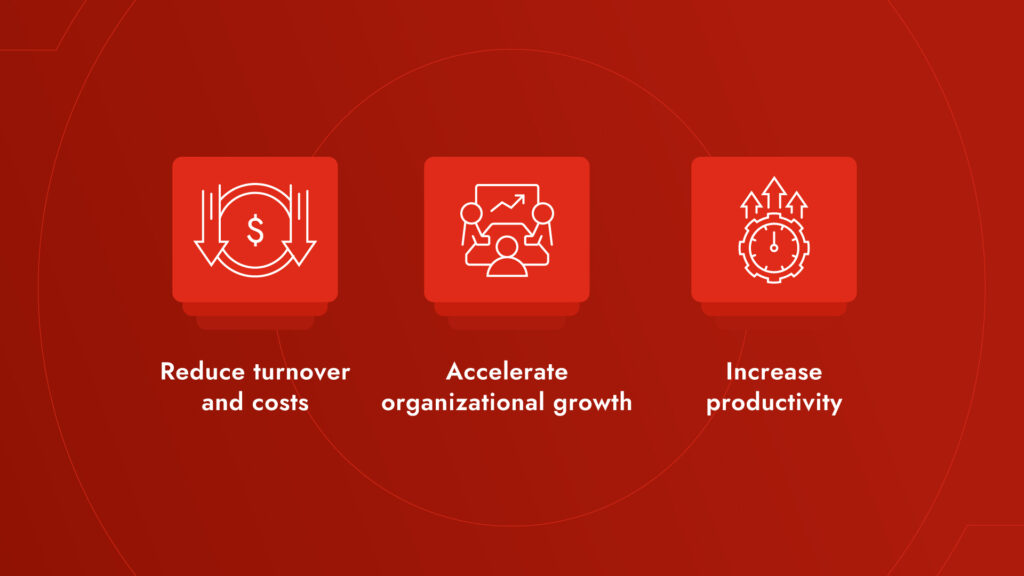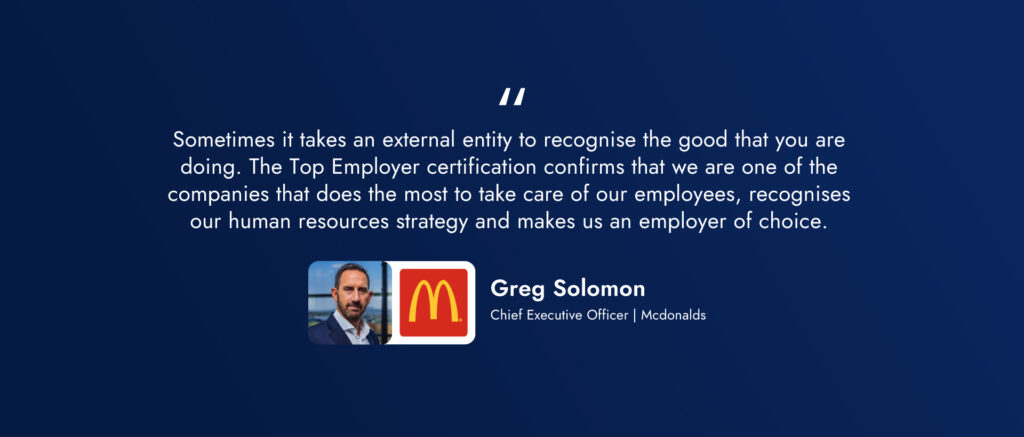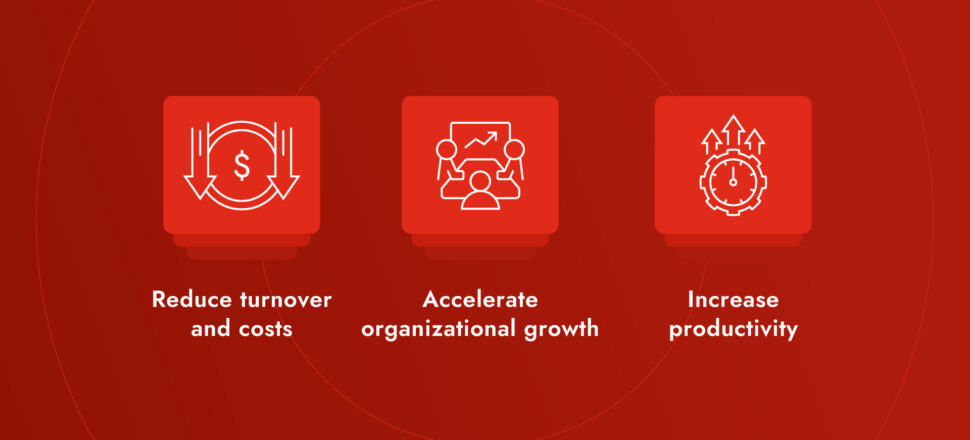The employee experience is broad, making it difficult to know where to begin with improving it. Successful companies need productive and engaged employees to deliver high-quality products and services, which will depend on how they interact with the environment around them at work.
Company culture, work-life balance, technology, digital tools and physical tool they are supported with are just a few of the crucial factors that influence the relationship between employees and their employer.
In this article, we’ll break down the key elements of a successful employee experience strategy, examples and the numerous benefits organizations will reap from their efforts.
Moreover, we will unveil how your oragnization’s employee experience can benefit by joining the Top Employers Institute program.
What Is The Employee Experience?
The employee experience refers to every interaction an individual has with your organization throughout their employee lifecycle. From reading the job posting to their exit interview, the employee experience is not just about work-related tasks but also the perceptions and feelings an employee develops about his or her employer.
The employee experience encompasses a holistic view of a person’s relationship with their employer, including company culture, the daily working environment, technology and resources available to employees, opportunities for personal and professional growth, and to what extent the organization supports and encourages work-life balance.
Creating a positive employee experience is key to boost organizational success but it requires organizations to understand that they must do more than provide their employees’ basic needs. They must strive to create an environment that enhances employees’ lifecycle – in and out of the workplace.
Employee Experience Strategy: key elements for organisational success
For all the reasons mentioned above, the employee experience needs a real strategy. Here are some key elements organizations can consider when crafting and revising their employee experience management strategy.
Company Culture
Company culture is the foundation of the employee experience. It includes the values, mission, and goals that shape the behavior of leadership and management and guide the company’s trajectory. A positive and nurturing culture fosters an atmosphere of respect, collaboration, and openness.
When employees feel that the company culture aligns with their personal values, they are more likely to be committed to the company on a deeper level.

Work Environment
The physical workspace is another crucial component of the employee experience. Employees spend a significant portion of their lives at the office, so the design and functionality of the workplace can significantly impact their well-being and perception of the organization.
Natural light, ergonomic furniture, quiet spaces for independent work, and communal areas for collaboration are all factors that influence how people feel about their workplace.
With hybrid work increasingly becoming the norm, the work environment also includes employees’ home workspaces and the tools provided to support their productivity. Offering flexibility and ensuring employees have the right resources, whether in the office or working remotely, contributes to a positive overall experience.
Technology
The tools and technology employees use for daily tasks have an immense impact on their journey. Outdated equipment, cumbersome processes, and inefficient systems can cause frustration and hinder productivity.
Ensuring your organization optimizes the digital employee experience can help teams stay connected, especially in hybrid workplaces.
Professional Development Opportunities
Employees want to feel that their employers are invested in their personal and professional growth. Offering continuous learning opportunities, training programs, and clear career advancement paths communicates to employees that your organization values their development.
Leadership & Management
Leaders set the tone of company culture and their management style directly impacts how employees perceive their work. Leaders who prioritize transparency, communication, and recognition contribute to a positive employee experience.
How To Improve The Employee Experience: Examples & Strategies
Improving the employee experience is a continuous, multifaceted process. Organizations that establish ongoing initiatives are best positioned to successfully provide a positive employee experience.

Personalize the Employee Experience
There is no one-size-fits-all solution for an effective employee experience strategy. Many organizations have a multi-generational, multi-cultural workforce, making employee insights extremely valuable. Organizations need to design an inclusive and flexible workplace so that all team members can get their needs and preferences met.
Encourage Regular Feedback
When trying to improve the employee experience, knowledge is power. The more feedback you can get from employees, the better you’ll be able to respond to their needs and concerns.
360-degree surveys, one-on-one meetings, and focus groups can provide valuable insights into what is working well and identifying growth opportunities.
However, collecting feedback is only one step in the process. Organizations need an HR analytics system to review the data and take action accordingly.
Seeing changes resulting from their feedback encourages employees to continue vocalizing their needs and observations as they arise, rather than waiting until they develop into a problem.
Foster Employee Well-Being
By promoting work-life balance, organizations demonstrate their dedication to mental health and well-being. Offering flexible schedules, hybrid work options, and time off for professional development opportunities are all ways companies can facilitate employees maintaining a balance between their personal and work lives.
Benefits of Creating A Positive Employee Experience
The employee experience is all-encompassing and the results of investing in it will similarly be just as broad. No aspect of your organization will be left unimpacted. Here are some tangible benefits your organization can expect from improving the employee experience.
Increase Engagement & Productivity
Organizations that invest in a positive employee experience see a direct impact on engagement and productivity. Engaged employees are emotionally invested in their work and the organization’s success.
They are more likely to go above and beyond in their roles, leading to higher levels of productivity and innovation. Engaged and happy employees are also less likely to experience burnout because of the satisfaction and meaning they derive from their work.
Improve Employee Retention
Creating a positive employee experience demonstrates that every employee’s journey is important. It communicates to each individual that the organization is invested in their success.
Seeing their company go the extra mile for their comfort and well-being means that employees are more likely to do the same to fulfil their roles and responsibilities.
Attract Top Talent
Current employees are essentially ambassadors of your organization’s employer brand strategy. Candidates can sense how fulfilled current employees are during the interview process. Enthusiasm is contagious and the appeal of joining an energized, engaged team is hard to resist.

Company Success and Innovation
Companies focusing on the employee experience often see higher profitability and better performance. Engaged and satisfied employees are more likely to be innovative, collaborative, and committed to the organization’s mission and goals.
This ripple effect extends into customer relations as well. When employees are motivated and engaged, they provide excellent work and service to clients, which boosts the organization’s reputation.
Improve the Employee Experience through the Top Employers Institute Certification
By investing in a positive, engaging work environment, companies can unlock higher levels of productivity, innovation, and retention. A dynamic employee experience fosters a culture of trust, collaboration, and purpose, contributing to individuals feeling valued and empowered to do their best work.

Ultimately, cultivating a positive employee experience is not just a strategy for success– it’s a critical foundation for long-term growth. As the global authority on excellence in people practices, no one understands this reality better than us. We combine years of research with analytics and advice from our robust global community to help organizations become an employer of choice.
